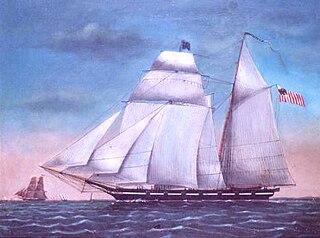This page is based on this
Wikipedia article Text is available under the
CC BY-SA 4.0 license; additional terms may apply.
Images, videos and audio are available under their respective licenses.
Gallatin may refer to the following:

The United States Revenue Cutter Service was established by an act of Congress on 4 August 1790 as the Revenue-Marine upon the recommendation of Secretary of the Treasury Alexander Hamilton to serve as an armed customs enforcement service. As time passed, the service gradually gained missions either voluntarily or by legislation, including those of a military nature. It was generally referred to as the Revenue-Marine until 31 July 1894, when it was officially renamed the Revenue Cutter Service.

United States Coast Guard Cutter is the term used by the U.S. Coast Guard for its commissioned vessels. They are 65 feet (19.8 m) or greater in length and have a permanently assigned crew with accommodations aboard. They carry the ship prefix USCGC.

The United States Revenue Cutter Crawford was the first of the 13 cutters of the Morris-Taney Class to be launched. These cutters were the backbone of the Service for more than a decade. Samuel Humphreys designed these cutters for roles as diverse as fighting pirates, privateers, combating smugglers and operating with naval forces. He designed the vessels on a naval schooner concept. They had Baltimore Clipper lines. The vessels built by Webb and Allen, designed by Isaac Webb, resembled Humphreys' but had one less port
Dallas has been the name of more than one ship of the United States Revenue Cutter Service and United States Coast Guard, and may refer to:
McCulloch or Hugh McCulloch has been the name of more than one ship of the United States Revenue-Marine, United States Revenue Cutter Service, or United States Coast Guard, and may refer to:
USRC Dexter was the name of more than one ship of the United States Revenue Cutter Service, and may refer to:
Dexter has been the name of more than one ship of the United States Revenue Cutter Service and United States Coast Guard, and may refer to:
USRC Active was the name of six vessels of the United States Revenue Cutter Service, and may refer to:
Active was a revenue cutter in commission in the United States Revenue Cutter Service from 1816 to 1825. She was the third Revenue Cutter service ship to bear the name.
USRC Hamilton was a Revenue Cutter topsail schooner of the Gallatin class. She was named for Alexander Hamilton, first Secretary of the Treasury. An iron-hulled cutter with steam propulsion, she was constructed at Buffalo, New York by David Bell Co. in 1871. The Gallatin class consisted of two ships, the USRC Gallatin and the Hamilton, however they differed in the propulsion machinery used.
USRC Virginia was a schooner built in 1797 for the United States Revenue Cutter Service at Portsmouth, Virginia. At the outset of the Quasi-War in 1798, the only ships available to the Navy were the 10 ships of the Revenue cutter service, the largest of which was the Virginia. She was transferred to the Navy in 1798 and served in the Quasi War until 1800, when she was returned to the Revenue Cutter Service, recommissioned in 1802 and sold in 1807.
USRC Virginia may refer to:
USRC Active, was a revenue cutter of the United States Revenue Cutter Service in commission from 1867 to 1875. She was the fifth Revenue Cutter Service ship to bear the name.
USRC Relief, was a revenue cutter of the United States Revenue Cutter Service in commission from 1867 to at least 1870. She was the first Revenue Cutter Service ship to bear the name.

USRC Surveyor was a ship of the United States Revenue Marine captured by the United Kingdom during the War of 1812. Despite the vessel's loss, the "gallant and desperate" defense of her crew against a superior force of the Royal Navy and the Corps of Royal Marines is commemorated by the United States Coast Guard. Along with the Royal Navy frigate which bested her in battle, HMS Narcissus, Surveyor is among six legendary ships memorialized in the lyrics of the Coast Guard march "Semper Paratus".




